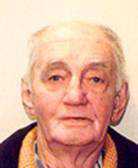RAYMOND BALDWIN
In Syria , Ray and his mates had their first experience of fighting at close quarters. The 2/27th took part in the coastal advance against Vichy French forces including French Foreign Legion forces. After the campaign, the battalion remained in Syria on garrison duties until January 1942 when it left to take part in the war against Japan. The battalion reached Australia in March.
After leave and further training, Ray was sent to Papua New Guinea with the 2/27th in August 1942. He fought on the Kokoda Track during the fighting withdrawal. At Efogi, he and 13 others were separated from the main force and were cut off behind Japanese lines for 14 days without food or shelter. By the time they reached friendly lines, Ray was hallucinating due to starvation.
After a short period recuperating, Ray was selected to be a member of Chaforce, a special force intended to undertake long-range fighting patrols in support of the counter-attack. However, he was injured when he accidentally slid down a coconut palm tree during training, rubbing the skin off his inner thighs. Instead, he and a mate were given a job of escorting some Papua New Guineans delivering explosives to the forward supply dump at Myola.
Ray returned to the 2/27th in Port Moresby and was flown to Popondetta in late November 1942. While taking part in one of the assaults on the heavily fortified Japanese positions at Gona, he received several shrapnel wounds from a hand grenade. Ray was evacuated to Port Moresby where he had the shrapnel removed and his wounds dressed. As soon as he was able to walk again, he absconded from the base hospital, leaving a note on the pillow thanking the doctors and nurses for taking care of him, and bluffed his way onto a transport aircraft headed for Popondetta. From there Ray walked unarmed back to Gona to rejoin his unit. His mates said he was 'bloody stupid' and an officer removed his Corporal's stripes as punishment.
Ray took part in the last of the fighting and the recovery and burial of Australian and Japanese dead before returning to Port Moresby in January 1943 and then back to Australia . Only three officers and 87 other ranks from 2/27th returned to Australia . Ray went on to serve in the Markham and Ramu Valley campaigns in 1943-44 and in 1945 landed at Balikpapan, Borneo, as a flame thrower operator. He returned to Australia in November 1945 and was discharged.
Ray found returning to civilian life was not easy. He felt unsettled and found he could not cope with working in the confined areas required in the glass trade. After several casual jobs, he re-enlisted in May 1946 and escorted German and Italian prisoners of war back to their home countries. He was also seconded to the Nuremburg Trials for one month and later spent four years in Malaya with 2RAR. He stayed in the Australian Regular Army until December 1970, being medically discharged as a Warrant Officer Class One. He then began working as a tipstaff in the Supreme Court and later as a truant officer for the South Australian Education Department.
Ray married Valma in July 1954 and they had two sons and one daughter. They now have five grandchildren. Ray's interests today are his family, walking, camping and swimming. He was also the editor of the 2/27th Battalion Journal, a position he held for the past 22 years.


Raymond Baldwin
